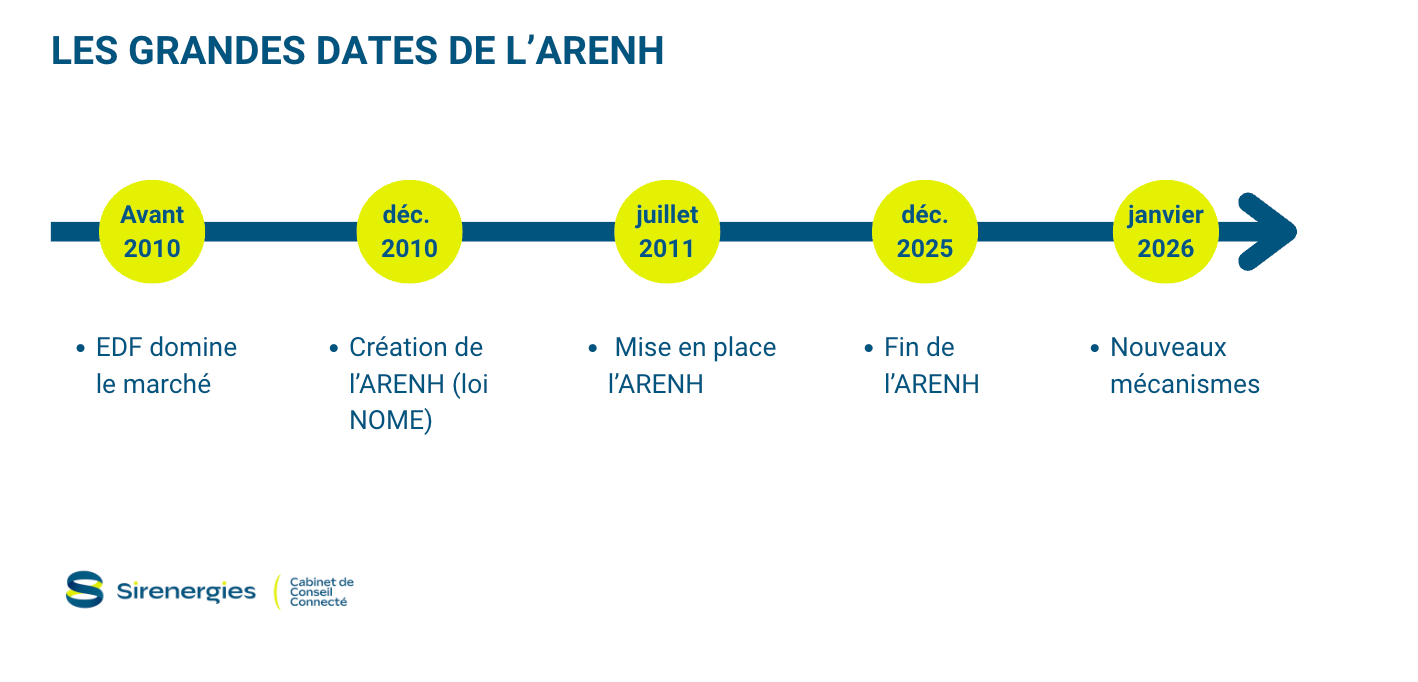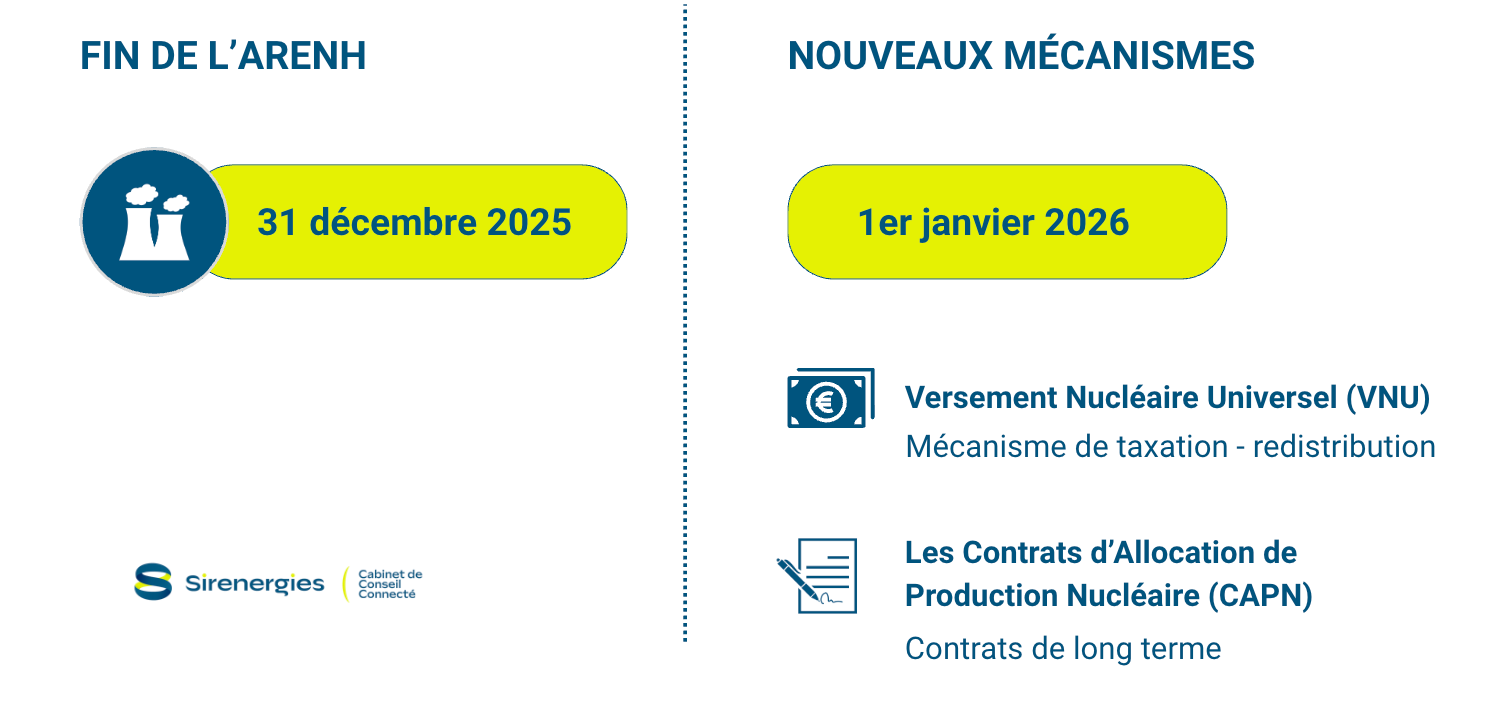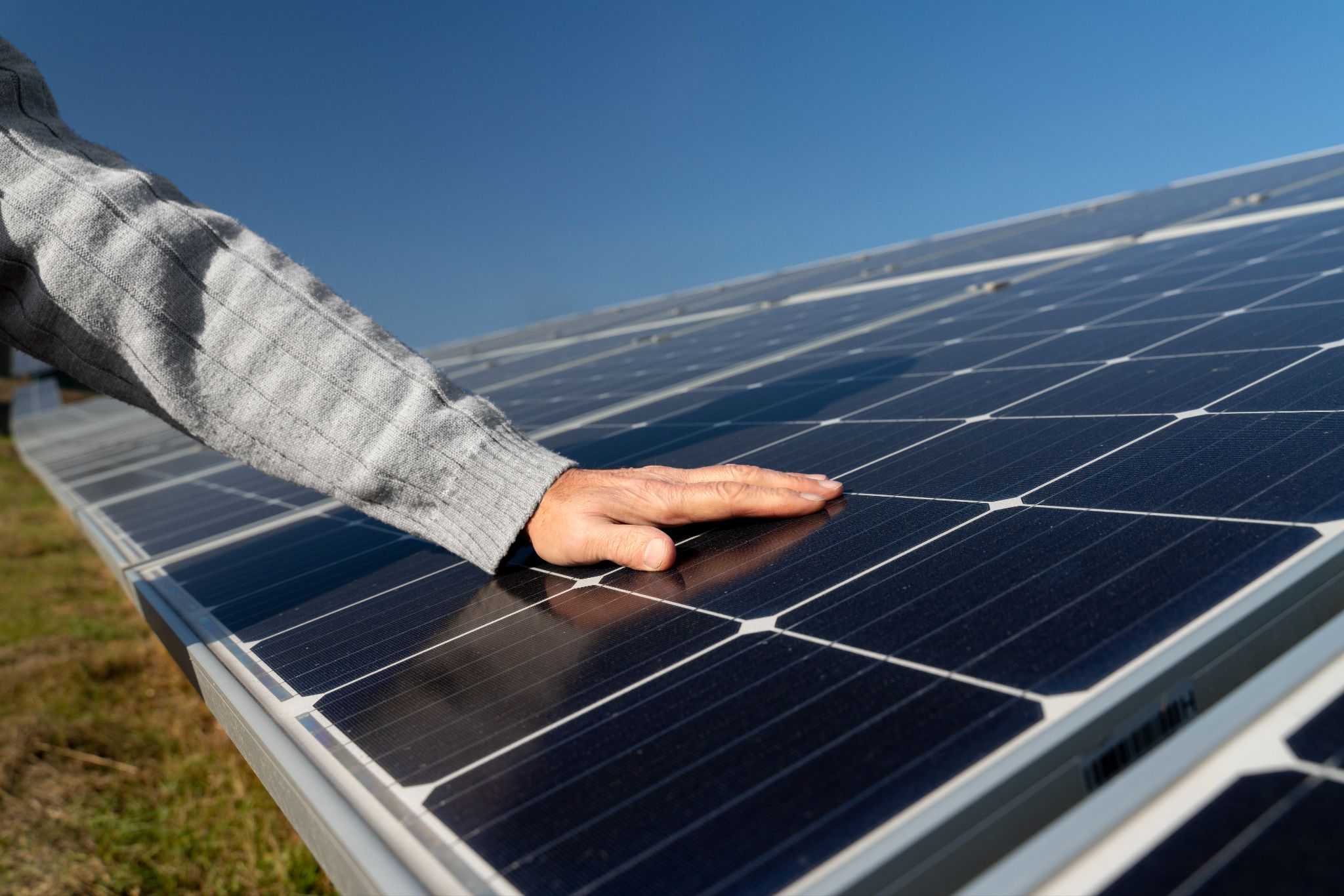

September 30, 2025
8
Min reading

The countdown is on.
On December 31, 2025, ARENH will bow out, fifteen years after its creation. From the 1Er January 2026, the rules of the game are changing. 100% of electricity will have to be purchased at market prices, with the associated risks of volatility.
For businesses, communities and professionals, the challenge is clear: anticipate, act and not suffer. This shift is being prepared now!
Why the end of ARENH? What are the consequences on electricity prices? What is it being replaced by? Discover our comprehensive guide to making the right decisions, securing your costs and avoiding unpleasant surprises in 2026.
THE ARENH (Regulated Access to Historic Nuclear Electricity) was set up in 2011 by the NOME law, to support the opening up of the electricity market to competition. Its lifespan, set at fifteen years, was confirmed as early as 2015 by the Energy Transition Law for Green Growth (LTECV).

Since its creation, ARENH has always been guided by two principles:
Capped at 100 TWh, the ARENH volume covered nearly a third of national consumption each year.
Despite its flaws and weaknesses, ARENH has helped to Containing the rise electricity prices for consumers.
He also gave budget visibility to businesses and professionals.
However, this device has never been unanimously accepted..
Its detractors - including EDF, electricity producers and the European Union - have continued to highlight its limitations:
From the 1Er January 2026, businesses will have to buy 100% of their electricity at market prices.
Today, one question challenges all businesses: How will electricity rates change?
Two major visions clash.
In a February 2025 press release, The UFC-Que choosing fears a “massive rise” electricity tariffs from 2026.
She estimates it on average at + 19%, or 250 euros extra per year for an average household.
If these forecasts based on 2025 market conditions are to be taken with caution, mathematical analysis would confirm an inevitable rise in prices.
For some experts, the calculation is simple: the ARENH was €42/MWh.
However, the lowest market forecasts for 2026 indicate prices around €60/MWh.
Mechanically, the post-ARENH increase would therefore represent 8 to 10 €/MWh (based on an ARENH fee of 50%).
Other voices want to be more optimistic. La fall in market prices, already observed for 2026, should compensate for the end of ARENH.
The government shares this reading, highlighting the various tools created to stabilize post-ARENH prices.
According to the Ministry of Finance, “The payment to the consumer provided for by the finance law for 2025 leads to a TRV level of 1Er January 2026 almost identical to the current level”.
The supply that is smoothed over two years should also cushion market fluctuations.
The end of ARENH does not weigh on all businesses in the same way.
Two new regulatory mechanisms must replace the ARENH starting from the 1Er January 2026.
But only three months before their entry into force, their outlines remain vague, fuelling debates and concerns, in an unstable and unreassuring political context.

Universal Nuclear Payment (UNV) will apply to all consumers in 2026. UNV is based on a mechanism of taxation — redistribution.
It must limit the surge in prices for consumers, while ensuring that EDF has sufficient income to develop the nuclear fleet.
Concretely, EDF will sell all of its nuclear production at market prices.
If this price exceeds production costs (estimated at €60.3/MWh for 2026-2028 by the Commission de Régulation de l'Énergie - CRE), EDF will have to pay back part of its excess income to the state.
Two thresholds are envisaged:
The amount will then be redistributed to consumers, in the form of automatic discounts, calculated in euros per MWh. A specific “VNU” line will appear on the electricity bill.
The administrative machine is now in operation.
As evidenced by a First decree published in September 2025 on methods for calculating nuclear production costs.
But, a few weeks before the changeover, the vagueness that still reigns over UNV is fuelling concerns:
Nuclear Production Allocation Contracts (CAPN) concern a minority of customers, whose electricity consumption exceeds 7 GWh per year.
Signed with EDF, the CAPN is a long-term contract (10 to 15 years) that guarantees large consumers:
In return, industrial consumers agree to sharing some of the costs and risks, via the payment of a deposit at the start of the contract and a variable portion, indexed to operating and fuel costs.
Despite these attractive promises, the CAPN was slow to take off, due to a lack of visibility and because of the sharing of risks.
But since the summer of 2025, signatures have been accelerating, a sign that manufacturers are looking to secure their costs in the long term.
Volatile prices, unpredictable bills, uncertain regulatory mechanisms: the disappearance of ARENH signals the end of a protective model for businesses.
A profound transformation is in the works. The key to not suffering it?
Anticipate now by adopting a proactive procurement and procurement strategy.
Buy the right product at the right time is the basis of an effective energy procurement strategy.
With Lowest market prices for 2026 and 2027, it may be time to renegotiate your electricity contracts.
According to Emmanuel Sire's analysis, buying at this price is “buy below the price of ARENH revalued taking into account inflation since 2012”.
However, vigilance is required. A return to the market is always possible, in view of global geopolitical instability.
What if you secured your prices over the long term to maintain your budgetary visibility and protect yourself from market fluctuations?
The end of ARENH is a certainty. Your energy strategy should not be a source of uncertainty. It is no longer time for waiting, but for action. Our experts are ready to audit your situation and work with you to build a clear road map for 2026.
[Schedule a 30-minute strategic interview]
The long-term contracts of 3 to 5 years are multiplying today. It is an opportunity worth seizing. Their less volatile prices more reflect the market fundamentals only external and conjunctural events.
Group energy purchases allow businesses, professionals and communities to pool their volumes, and therefore to benefit from better pricing and contractual conditions.
This winning strategy simplifies the procedures by delegating the negotiation and analysis of offers to an intermediary. However, it makes it impossible to design a personalized offer.

Producing and consuming part of your electricity reduces market dependence. Thanks to photovoltaic installations, self-consumption is now available to all businesses and professionals.
Already guaranteed today, the return on investment could accelerate with the rise in electricity prices on the markets.
Another sustainable and safe option to study: power purchase agreements (PPAs). These green electricity supply contracts are concluded directly with renewable energy producers.
In the long term, PPAs offer numerous advantages:
The cheapest electricity is the one you don't use. This oft-quoted formula recalls a simple truth: the best way to withstand price instability is to reduce consumption.
The adoption of eco-gestures by your employees is a first step. But this evidence requires rethink all energy consumption globally of your business, via:
Technical, complex and fast-paced, are you worried about the environment in the electricity sector? Don't stay alone.
An expert helps you negotiate your contracts, analyze the markets, buy your electricity properly or manage your energy strategy effectively.
At the end of the day, a Time saver, of optimized purchases, Of secure supplies, of risks avoided And a reduced electricity bill.
At Sirenergies, it's our job.
As an energy consulting and sourcing firm, we support companies, professionals and communities every day in their energy decisions.
Clarity, expertise, transparency are our key words to help you better control a constantly changing electricity market.
To find out more, click here.
To conclude...
The disappearance of ARENH marks a profound change for businesses, communities and professionals. Regulated rates give way to a market that is 100% exposed to price volatility. In addition, there are regulatory uncertainties, which are a source of many questions. But this upheaval is not inevitable. It offers the opportunity to rethink your energy strategy. Between renegotiation of contracts, diversification of supplies, group purchases or self-consumption, there are numerous levers to secure your costs and regain visibility. On one condition: take action today.
With Sirenergies, anticipate and structure your energy strategy today to better control tomorrow.

.png)

Communities are subject to taxes such as TICFE or TICGN. Sirenergies analyzes invoices, identifies exemption possibilities and fixes possible errors to reduce the tax burden.
.png)

Les profits include a direct reduction in bills, strengthened budgetary forecasting and better control of consumption. Businesses gain visibility and efficiency thanks to adapted tools.
.png)

Tertiary companies must manage their energy costs while guaranteeing the comfort of users (offices, shops, services). Consumption is often linked to heating, air conditioning and lighting, which requires precise monitoring to avoid budgetary excesses.
.png)

This makes it possible to choose the right time to contract, secure your budgets and anticipate increases.
.png)

Changing suppliers can allow you to benefit from more competitive prices, adapted services or better contractual conditions. Thanks to sourcing, change is happening without interruption of supply.
.png)

The subscribed power must be calculated according to the consumption profile and uses (heating, industrial processes, tertiary equipment). One fine analysis makes it possible to ensure the adequacy between real need and contract.
.png)

Among the taxes include TICFE, TICGN, CTA, CJA and TURPE. They represent a significant part of the bill and vary according to consumption profiles. Understanding them well is essential to optimize costs.
.png)

Exceeding capacity leads to financial penalties and can impact the size of the contract. Adjust the correctly subscribed power makes it possible to avoid these additional costs.

